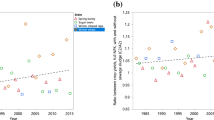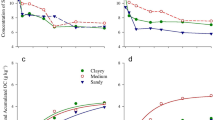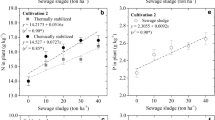Abstract
Enhanced microbial activity following sewage sludge land application may affect soil N cycling and, therefore, plant available N. We studied the effect of anaerobically treated sewage sludge on N-fertilizer efficiency and on some aspects of the soil N cycling. Field plots (3 m × 9 m) sown with barley (Hordeum vulgare L.) in November were amended with a) sludge (80 mg ha-1) and ammonium nitrate (150 kg N ha-1), b) ammonium nitrate (150 kg ha-1) only, c) or left unamended. Monthly soil samples were taken from 0 to 20-and 20 to 50-cm depths to determine soil inorganic N (NH4 +, NO3-). Denitrification in the upper 20-cm horizon was estimated by measuring N2O+N2 emission from undisturbed soil samples by the acetylene-inhibition technique. Crop yield parameters were analysed before harvesting, and grain production was recorded. With respect to the control, the yield increase for the N-fertilizer treatment was 85% and 45% for the sludge + N-fertilizer treatment. The decrease of N-fertilizer efficiency in sludge amended plots was presumably due to a decrease in spring plant available N. Presumably, microbial immobilisation and denitrification in organic amended treatments were responsible for the decrease in N-fertilizer efficiency.
Similar content being viewed by others

References
AOAC (1990) Official methods of analysis. 15th edn. Washington: Association of Official Analytical Chemists
Benckiser G, Gaus G, Syring KM and Sauerbeck D (1990) Field measured N2O and N2 release relationships with carbon turnover, soil nitrate contents, water tensions and temperatures. Mitteilungen der Deutschen Bodenkundlichen Gesellschaft 60, 189–196
Bremner JM (1965) Nitrogen availability indexes. In Black et al. (eds.) Methods of soil analysis. Part 2, pp. 1162–1164. Madison, Wisconsin: American Society of Agronomy
Cimino G and Toscano G (1993) Effects of digested sewage sludge on yield and heavy metal accumulation in horticultural species. Bioresource Technol 46, 217–220
Edwards JH, Burt EC, Raper RL and Walker RH (1995) Issues affecting application of noncomposted organic waste to agricultural land. In: Karlen DL et al. (eds.) Agricultural Utilization of Urban and Industrial By-Products, pp. 225–249. Madison, Wisconsin: American Society of Agronomy
Epstein E, Keane DB, Meisinger JJ and Legg JO (1978) Mineralization of nitrogen from sewage sludge and sludge compost. J Environ Qual 7, 217–221
Garcia C, Hernandez T and Costa F (1991) The influence of composting on the fertilising value of an aerobic sewage sludge. Plant Soil 136, 269–272
Heras SG, Nijensohn L and Maffei JA (1991) Interactions between digested sewage sludge and ammonium sulphate or urea fertilizer application to maize. Agrochimica 35, 422–433
Kandeler E, Eder G and Sobotik M (1994) Microbial biomass, N mineralization, and the activities of various enzymes in relation to nitrate leaching and root distribution in a slurry-amended grassland. Biol Fertil Soils 18, 7–12
King LD (1973) Mineralization and gaseous loss of nitrogen in soil-applied liquid sewage sludge. J Environ Qual 2, 356–358
Linster M (1991) The impact of sewage sludge on agriculture. In: Young MD (ed.) Towards Sustainable Agricultural Development, pp. 320–336. London: Belhaven Press
Martins D and Kowald R (1988) The effect of repeated applications of refuse compost on a silt loam arable soil. Zeitschrift fur Kultur Technic und Flurbereinigung 29, 234–244
Nicholas JC and Nason A (1957) Determination of nitrate and nitrite. Method Enzymol 3, 981–984
Rolston DE, Hoffman DL, and Toy DW (1978) Field measurement of denitrification: I. Flux of N2 and N2O. Soil Sci Soc Am J 42: 863–869
Ryan JA, Keeney DR and Walsh LM (1973) Nitrogen transformations and availability of an anaerobically digested sewage sludge in soil. J Environ Qual 2, 489–492
Sabey BR and Hart WE (1975) Land application of sewage sludge: effect on growth and chemical composition of plants. J Environ Qual 4, 252–256
Solorzano L (1969) Determination of ammonia in natural waters by phenolhypochlorite medium. Linmmol Oceanogr 14, 799–801
Tessier A, Campbell, PGC and Bisson M (1979) Sequential extraction procedure for speciation of particulate trace metals. Anal Chem 51, 844–851
Verdu I, Gomez I, Burlo F, Mataix J (1991) Influence of phosphorus on nitrogen mineralization of sewage sludge in two calcareous soils. Application of EUF procedure. Suelo y Planta 151–161
Walkley A and Black I A (1934) An examination of the Degtjareff method for determining soil organic matter and proposed modification of the chromic acid titration method. Soil Sci 37, 29–38
Author information
Authors and Affiliations
Rights and permissions
About this article
Cite this article
Lasa, B., Quemada, M., Frechilla, S. et al. Effect of digested sewage sludge on the efficiency of N-fertilizer applied to barley. Nutrient Cycling in Agroecosystems 48, 241–246 (1997). https://doi.org/10.1023/A:1009798509654
Issue Date:
DOI: https://doi.org/10.1023/A:1009798509654



